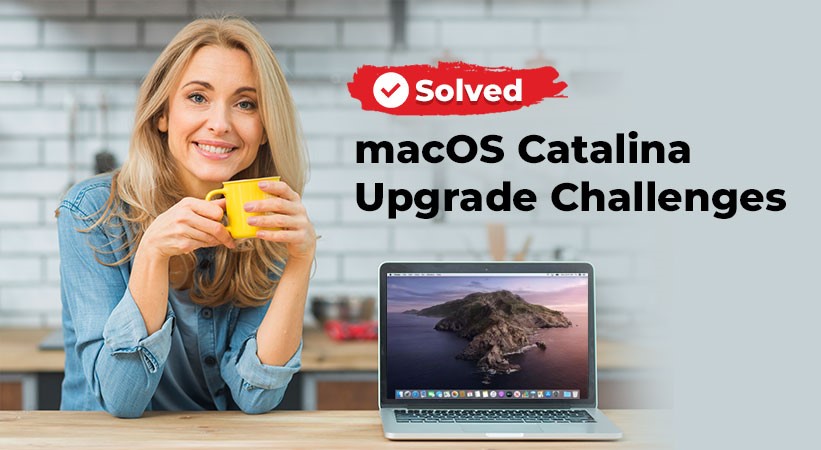Apple has recently released the new macOS Catalina 10.15.3 for its Mac line of computers. Many of you may have upgraded your Mac with this latest macOS. Congratulations to all who could make a successful upgrade. And those who haven’t, couldn’t, or are facing some challenges after the upgrade, don’t worry. In this post, we’ll solve fundamental macOS Catalina challenges in three stages: before the upgrade, during the upgrade, and after the upgrade.
Before-Upgrade Challenges on macOS Catalina
Is my Mac upgradeable to macOS Catalina?
Not all Mac devices support Catalina. Only compatible MacBook, iMac, Mac mini, and their Pro models that are created after a specific year (say 2012 or later) qualify for the upgrade. Check compatible Macs. To know your Mac model, go to Apple menu > About This Mac. If your Mac is incompatible, then it’s the right time to upgrade your Mac. Get a new Mac that comes preinstalled with macOS Catalina or can be upgraded to the new OS.
What precautions should I take before upgrading to macOS Catalina?
When you have confirmed that your Mac is compatible with macOS Catalina, don’t upgrade it straight away. Else, you may end up losing all your stored data from the Mac due to drive erasure. To avoid permanent data loss, back up your Mac by using Time Machine backup drive. Go to Apple menu > System Preferences > Time Machine. Click Select Backup Disk, select the external backup drive, then click Use Disk. Time Machine backs up your Mac automatically.
How to upgrade my Mac to macOS Catalina?
Once you’ve taken the backup, connect your MacBook Air/Pro or other Macs that you own to its power source. Also, ensure there is an active internet connection. If you’re using macOS Mojave, go to Apple menu > System Preferences > Software Update. Click the Upgrade Now button. Or else, go to Mac App Store > click the Get button or iCloud download icon to download macOS Catalina. Use the downloaded macOS Catalina installer to upgrade your Mac.
During-Upgrade Challenges on macOS Catalina
Why my Mac can’t upgrade to macOS Catalina?
The new macOS Catalina requires at least 4 GB of memory and 12.5 GB (or 18.5 GB if you are using OS X Yosemite or earlier) of storage space. When you’ve backed up your Mac, create 30 GB of available startup disk space to smoothen macOS Catalina download, install process. To free up usable space, delete unnecessary files, move your essential data from Macintosh HD to another volume, or increase startup disk size.
How to rid of macOS Catalina get stuck or freeze state?
It is quite reasonable for the macOS installation process to take time. But, sometimes even after having sufficient startup disk space, your macOS installation may get stuck or freeze. If your Mac doesn’t respond, then press the power button for few seconds to force shut down. Restart your Mac and immediately press the Shift key to boot into Safe Mode. Launch the macOS Catalina installer once again and complete the installation process in Safe Mode.
After-Upgrade Challenges on macOS Catalina
Why don’t some apps work on macOS Catalina?
Apple has already intimated Mac users and developers that 32-bit apps won’t work on macOS Catalina 10.15. So some legacy apps that aren’t upgraded to 64-bit architecture won’t function in Catalina. To check 64-bit compatibility, go to Apple menu > About This Mac > System Report. From the sidebar, select Applications under Software. Look for all apps that are not compatible with 64-bit. Uninstall them. Look for alternatives that are compatible with macOS Catalina.
Why no iTunes on macOS Catalina?
Apple has annihilated iTunes from macOS Catalina. But, spit its functionality in three different entertainment apps—Apple Podcast, Apple Music, and Apple TV. These innovative apps won’t take much learning to acquaint yourself with their interface and functionality. Also, all your purchased items from iTunes are ported to the corresponding apps, so need not worry.
How can I recover lost data on macOS Catalina?
Use Time Machine backup to restore your lost, deleted, inaccessible, encrypted, formatted, or older-version data on macOS Catalina. If you don’t have a backup, don’t fret. Use a data recovery software like stellar that works harmoniously with macOS Catalina. If you haven’t created a Time Machine backup drive yet, create it to avoid future data loss. Also, sync Mac folders to iCloud.
Conclusion
Apple’s new macOS Catalina 10.15 is released. And Mac users who are testing the beta version have pointed out many issues with the OS. Thankfully, the current version of macOS Catalina has fixed almost all of them to provide best macOS experience ever with power-packed features and innovative apps.
We hope the post has helped you resolve fundamental macOS Catalina upgrade challenges in three easy to understand stages. Also, we shared solutions and alternatives that ensure you can use the latest macOS without any hitches.
Also, the DIY macOS upgrade process is quite easy if you follow the instructions correctly. If you haven’t backed up your Mac before macOS Catalina upgrade or your Time Machine backup drive itself has turned corrupt, then use a Mac data recovery software to recover your lost data.
